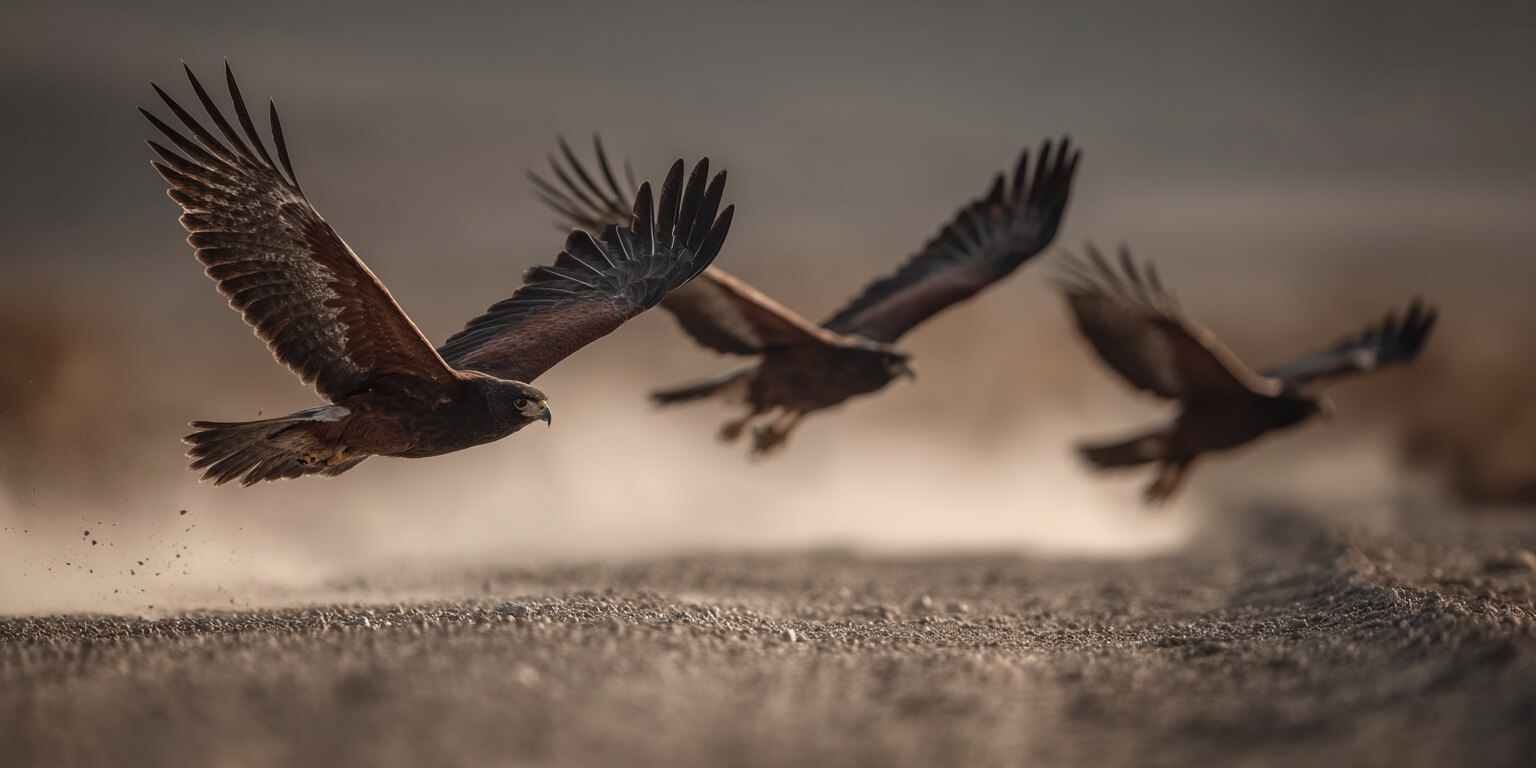Harris’s Hawk
The Cooperative Raptor
The Harris’s Hawk, scientifically known as Parabuteo unicinctus, is a remarkable bird of prey that blends striking beauty with a rare social nature. Renowned for its intelligence, agility, and teamwork, this hawk captivates anyone fortunate enough to observe it in action. Whether soaring through the skies or perched with an intense gaze, the Harris’s Hawk embodies the wild spirit of the desert, offering a glimpse into the intricate world of raptors.

A Stunning Appearance
The Harris’s Hawk is a study in elegance and power. Its dark brown plumage shimmers in the sunlight, offset by vibrant chestnut shoulders and thighs that glow like embers during flight. A crisp white band at the base of its tail serves as a striking marker, visible as the hawk twists through the air. Its piercing yellow eyes radiate focus, paired with a sharp, curved beak built for precision. Both males and females share this bold look, though females tend to be slightly larger, weighing up to 2 pounds with a wingspan approaching 4 feet. Every feather is tailored for agility, from the broad wings that enable sharp turns to the long tail that acts like a rudder in flight. This hawk’s appearance is a perfect balance of form and function, a testament to nature’s artistry.
A Social Hunter
Unlike most birds of prey, which hunt alone, the Harris’s Hawk thrives in groups, displaying a level of cooperation rare in the raptor world. Native to the arid regions of the Americas, from the southwestern United States to South America, these hawks form tight-knit family units in the wild, often consisting of a breeding pair and their offspring. Their teamwork is a marvel: one hawk might swoop low to flush out prey like rabbits, rodents, or small birds, while others circle above to block escape routes. Sharp, rasping calls echo between them, coordinating their efforts with precision. This collaborative strategy boosts their hunting success and strengthens their bonds, making them one of the most social raptors on the planet.
This sociability extends beyond hunting. Harris’s Hawks are known to share food with their group and even assist in raising younger siblings, behaviors that highlight their loyalty and intelligence. Their ability to work as a team has made them a favorite among falconers, as they readily form trusting relationships with humans, treating handlers as part of their pack. This unique trait sets them apart, offering a window into a complex social structure that feels almost familial.
Hunting Style: Agility and Strategy
The Harris’s Hawk is a versatile predator, equally skilled at high-altitude soaring and low, weaving pursuits through scrubby terrain. Its broad wings and long, fan-like tail provide exceptional control, allowing it to execute tight turns and sudden dives with grace. In the wild, these hawks often perch on low vantage points—cacti, shrubs, or fence posts—scanning the landscape with eyes that miss nothing. When prey is spotted, they launch into a swift, low glide, their talons poised to strike with crushing force. Their beak delivers a quick, efficient finish, ensuring minimal struggle.
Their hunting style is as strategic as it is athletic. By working in groups, they can tackle prey larger than any single hawk could manage alone, using tactics that showcase their intelligence. One might startle a rabbit into the open, while another waits to ambush it, creating a seamless relay of pursuit. This combination of physical prowess and clever planning makes the Harris’s Hawk a formidable hunter, perfectly adapted to the challenges of its desert home.
Why the Harris’s Hawk Fascinates
The Harris’s Hawk is a bird that commands attention, whether through its fiery plumage, dynamic flight, or captivating social behaviors. Its cooperative nature challenges the stereotype of the lone predator, revealing a raptor that thrives on connection and strategy. For those who watch it soar, dive, or perch with quiet confidence, the Harris’s Hawk offers a lesson in balance: power tempered by loyalty, independence enriched by community.
Its appeal lies in its accessibility as well. The Harris’s Hawk’s calm demeanor and intelligence make it a standout in falconry, where it shines in demonstrations of speed, precision, and teamwork. Its expressive face—those bright eyes and subtle head tilts—draws in observers, sparking curiosity about the lives of wild raptors. Beyond its physical gifts, this hawk carries a deeper message about the importance of protecting the fragile desert ecosystems it calls home, where habitat loss poses a growing threat.
The Harris’s Hawk is more than a bird; it’s a story of survival, collaboration, and grace. Encountering one, whether in the wild or through the ancient art of falconry, is an experience that lingers, inspiring awe for the intricate beauty of the natural world.